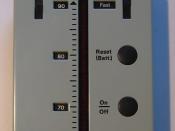Sound pollution is a very real problem in society today. It affects our everyday life and our behavior, and can be caused by the smallest things. Sound pollution, by definition, is any intrusive sound or imbalance in soundscape brought upon by another sound (source 1). This doesn't necissarily mean that it is a particularly loud or harsh sound, as the characteristics of an imbalancing sound can be pretty much anything. When people's environment is sonically polluted, the trend is that their behavior and level of concentration changes. However minute, these intrusive sounds can put a person on edge and affect their behavior.
When a person says sound pollution today, most people immediately think to the city noise that is all around us - car horns, people yelling, machinery. These are all sound pollution, and serious. However, these are all much more easily reduced than the second type of sound pollution - Ambient Noise.
Under the city noise lies another problem created by all machinery - ambient electronic sound. Basically, it is a low frequency noise given off by anything, most always a Bb on the western pitch scale. These devices emit a low, non-fast moving frequency wave, usually in a quite low pitch. This wave is percieved by all humans, though we may not ever identify it. It's as if that light in the corner of the classroom is constantly stuttering on and off and producing an obnoxious buzz - only when it's turned off can people really hear the difference. Sound pollution can and does causes stress, and if prolonged can even cause partial deafness and hearing problems.
Sound pollution is something measurable in decibels (DB). Zero Decibels is basically the quietest a healthy ear can hear, while 130 and more is considered extremely stressing and dangerous..


